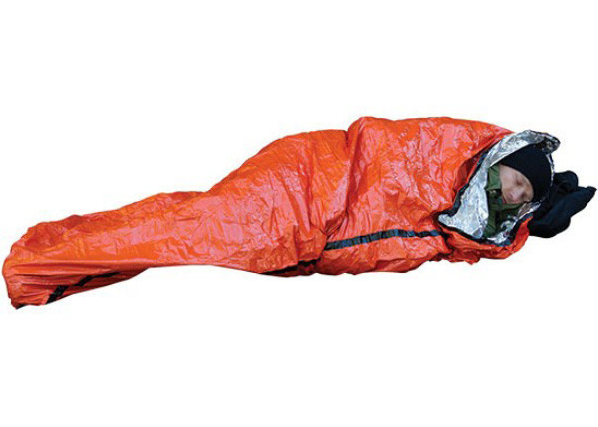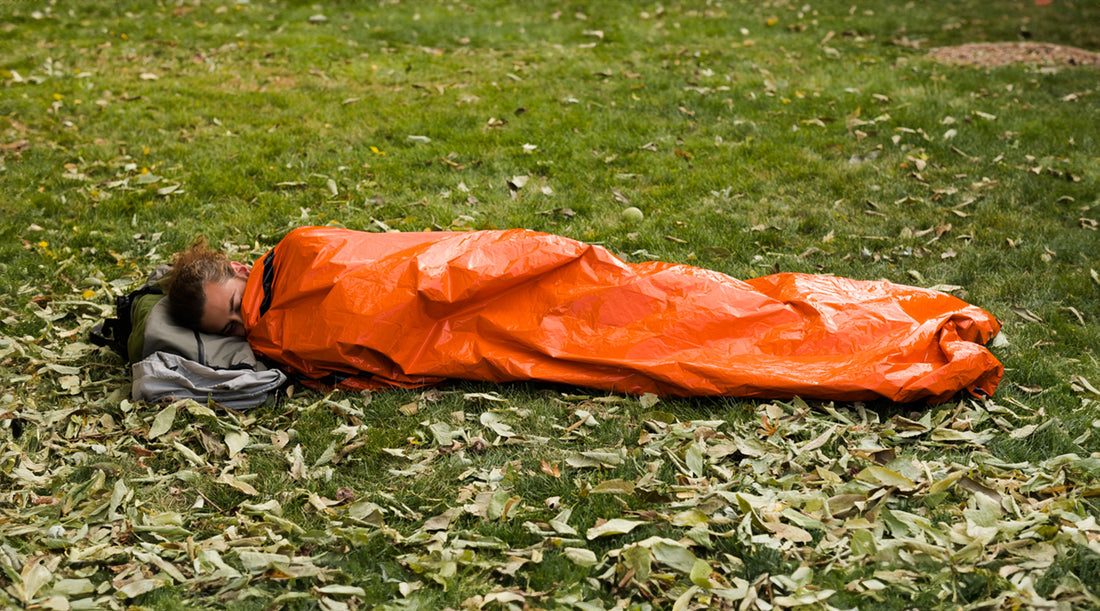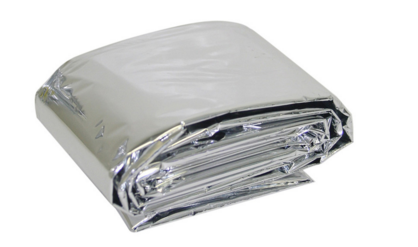These Uses For Survival Blankets Will Blow Your Mind
One of our top selling pieces of survival gear here at Survival Frog are the Emergency Survival Blankets (go here to save big on our blankets).
These lightweight, affordable blankets came into existence after NASA started to use the reflective material (called) Mylar in it’s manned and unmanned space flights.
Once people realized the incredible thin and durable material was great at reflecting heat back to its heat source they people in the survival/emergency community began to use them.
Here’s what Wkipedia says about space blankets.
A space blanket (also known as a Mylar blanket, first aid blanket, emergency blanket, thermal blanket or weather blanket) is an especially low-weight, low-bulk blanket made of heat-reflective thin plastic sheeting.
Their design reduces the heat loss in a person’s body which would otherwise occur due to thermal radiation, water evaporation, or convection. Their compact size before unfurling and light weight makes them ideal when space is at a premium. They may be included in first aid kits and also in camping equipment. Lost campers and hikers have an additional possible benefit: the metallic surface appearance flashes in the sun, allowing use as an improvised locator-beacon for searchers.
Now here’s the cool thing about these emergency space blankets.
Not only are they great for emergency use when keeping warm is at the front of mind, they also have other, more unique uses.
Yes, these uses could help save your life…but more importantly they can make homesteading or a SHTF situation much more bearable.
Some of these uses will help you save money on the cost of cooking food, others can keep you and your gear safe if you’re forced to rough it outdoors.
Ready for this?
Uses For Survival Blankets You Never Knew Existed
1 – Use them to cook meals:
Believe it or not you can use an emergency survival blanket to cook food with a DIY solar oven. What you’re going to do is use the blanket to capture and reflect the sun’s rays onto food you’re cooking. Typically this works well if you’re working with thin slices of meat. Thin slices of meat don’t need to be cooked much more than 165° F.
If you’d like a video tutorial, take a look at this (aluminum foil can be exchanged for an emergency blanket):
2: Use it as a signal mirror:
If you have have an emergency blanket then you have access to a signal mirror.
There are a couple of ways to do this, I recommend using a knife to cut off a 4’x4′ corner of the blanket off and use that as your mirror. This way you still have most of the blanket leftover and still have a large enough portion of blanket for reflecting.
Then take that piece of the blanket and take the rays of the sun and direct them towards a rescue party, or a plane. Ideally you want to keep the material as flat as possible, so if you have something small and flat you can stretch the portion of blanket over it and tape or tie it off in the back to get that nice, taut texture for proper reflection.
3 – Use strips of blanket to catch fish:
If you’re an angler you’re already familiar with reflective lures and their power to attract certain kinds of fish.
If you’re ever in an emergency situation and need to rustle up some dinner then you can cut small strips of the blanket off and then tie them close to the hook to attract fish. To increase the effectiveness of the blanket lure you can combine the blanket with some real bait to get fish on your hook.
4 – Use them to dry your clothes:
The reflective ability of the blanket can translate into drying clothing at a rapid rate.
This is actually incredibly important as wet clothes in a survival situation can provide a kiss of death (wet clothing can quickly lead to hypothermia).
There are a few ways to make this work, but one of the easiest is to simply place the damp (not soaking wet) clothing on the blanket and put it out on the sun to dry. Another way to help make this work is to place clothing on a clothes line and then place the clothing over the blanket so the reflection of the sun’s rays will bounce the sun’ s rays onto the back (unexposed side) of the clothing for quicker drying.
5 – Use them in for emergency first aid:
Not only will the blankets help keep someone who’s in shock or suffering from hypothermia warm, they can also be used as makeshift tourniquets or slings.
Mylar as a surprising amount of tensile strength, if you cut it cleanly (no ragged edges, or strips hanging off), you can use them for helping reduce your chances of bleeding out (see the video below on proper tourniquet tying) as well as to support a broken arm, or to splint a broken leg.
6 – Use them to gather water:
If you’re ever in a situation where access to emergency water is both critical and limited, an emergency blanket can be used to
gather rain water, or to trap condensation in the morning.
If you’re trying to use the blanket for gathering water all you have to do is tie the blanket up with some paracord and create a funnel so water naturally travels down the path of the blanket into your rain catcher.
If you want to use it to attract morning dew one of the best things to do is lay the blanket out flat and slightly elevated off of the ground (this allows cool air to travel under the blanket and promote the formation of condensation). Then when the morning comes grab the blanket by all four corners forcing the dew to the center and then guide the water into a container.
7 – Use them to protect your plants:
Those who have a survival garden know how inclement weather can provide a death sentence for food.
Emergency blankets can be used in both hot and cold weather to protect the plants. In hot weather the blanket can be draped over plants sensitive to the heat. The blanket will cause the sun’s rays to reflect off of the blanket, which will help keep the plants cooler. They can also be used to trap moisture.
In cold weather the opposite is true. Heat escaping from the ground will reflect back to the plants and then frost will be kept off of the plants. Because the blankets are so cheap you can tape many of them together for covering larger gardens.
8 – Use them as ground cover for camping:
An emergency blanket inside of a tent is a great weather proofer for camping. You can lay them down either inside a tent, or underneath a sleeping bag to keep moisture from seeping up from the ground and getting you wet.
Emergency blankets are so effective at this they’ve even created integrated bivy sacks that help keep heat in and weather out.
The Sol Bivy sack is great as a standalone in an emergency – click here or on the picture to learn more about it.
9 – Use them as cordage:
It should go without saying, cordage is a survival essential…meaning you probably shouldn’t leave home without some paracord or similar emergency cordage.
That being said if you’re ever caught in a bad situation and have no cordage an emergency blanket can be used as replacement cordage.
In case you need a cordage, you can use strips of blanket, braided together to help improvise one. Large braided pieces of blanket can even serve as a makeshift rope in some cases. Please keep in mind that such rope might not be safe enough to climb with, but it can be used as emergency cordage to help you build a shelter, or even to secure your gear.
10 – Use it to warm a temporary shelter fire:
This is very similar to the application you find with solar cooking.
Mylar is extremely tolerant to heat, it’s got a melting point of 489.2 ° Fahrenheit, that means you can keep it several feet from a fire and then angle it towards you to help keep some of the heat on your and your friends.
This application can also be used if you’re ever got a survival dwelling you want to heat. Blankets lined around a fire pit and on the ceiling can help to keep warmth inside of the shelter.
11 – Use them to cool or heat your home:
If you decide to bug in one of the best ways to help keep your home cooler or warmer, depending on the weather is to use emergency blankets on the windows.
You can put blankets on the inside of your windows in the summer to help blackout the windows and to keep heat out. In the winter you can do the same thing. Taping the blanket over the window sill will help trap air and adds a layer of insulation between that’ll help keep heat in. Plus, the blanket can reflect heat back into the home.
12 – Use them to waterproof supplies:
An emergency blanket is completely waterproof and this makes it ideal to wrap or shield items from falling water. Wilderness survivalists used to backpack items wrapped in a Mylar blanket in order to keep them dry when crossing rivers.
You can keep the contents of your backpack dry by placing everything on the blanket then wrapping it prior to placing it in the pack. Others used to wrap foods and other vital items in an emergency blanket and bury it when leaving the campsite. This would protect their items from wild animals or wanderers that would stumble into their campsite.
The Best Part about Emergency Survival Blankets?
Now that you’ve discovered 12 of the coolest uses for survival blankets it’s time you learn why we (and millions of other preppers) love them so much.
They’re CHEAP.
Not cheaply made mind you, just downright affordable.
Right now we have a special deal on the blankets.
Our Buy One Get One Free deal is available when you follow this link or click on the image below.


